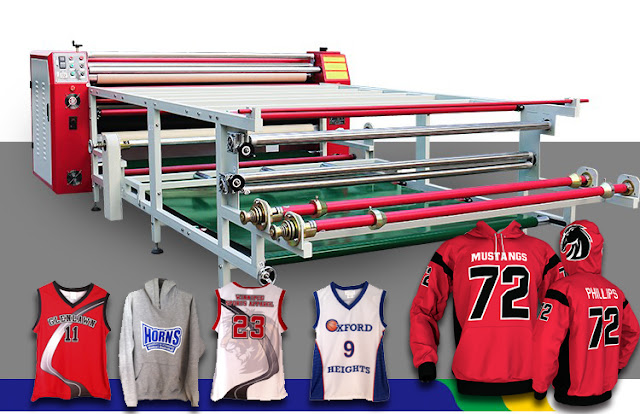Be Careful in each sublimation printing steps
The steps of dye sublimation are as follows:
An image is printed through a specialized RIP (raster image processing software) onto a coated dye sublimation transfer paper using dye sublimation inks.
The paper print is left to dry completely, and often set under the platen of a heat press – but not pressed – to ensure it is completely moisture free.
The print is taped or adhered to a substrate, like metal, wood, glass, tile or fabric. The tape must be heat-resistant to at least 450ºF.
A heat press is heated to 400º (depending on the substrate), and the printed paper and substrate are placed into the press.
And this is where the magic happens! In the heat press, the dye ink molecules are under extreme heat and pressure, which makes them “sublime”. This is where the term “sublimate” comes from.
The ink molecules bypass the liquid state of matter and move directly from a solid on the paper to a gas.
The coating on the substrate – a special kind of polyester – also goes through a shift in its state of matter, but not to a gas: it “glassifies”, meaning it transitions almost to a liquid but still holds its structure as a solid.
The dye sublimation ink gas molecules have nowhere to go but into the glassified polyester coating on the substrate, due to the extreme pressure in the heat press.
Once the allotted time is up, the substrate is removed, and the print is peeled away. The dye ink has been transferred integrally into – literally in between the molecules – the polyester coating!
The printed image is now permanently embedded into the coating on the substrate.
The trick with dye sublimation printing – and more specifically, with the actual subliming that happens in the heat press – is that the variables are much more than just “getting the color right”.
Everything involved in the process can result in issues with making a perfect print! If the substrate gets too hot too fast, or not hot enough, the image might not transfer. If the heat press misreports its temperature (it happens! sometimes upwards of 20º off!). If there is too much moisture in the print. If there is too much moisture in the substrate. If there’s too much moisture in the protective paper above or below the print or the substrate in the heat press. If there is too much moisture in the air. Moisture can be…quite an issue.
Inside the heat press under that extreme temperature and pressure, everything is moving…even at a minute scale. The paper the ink is on contracts. The metal expands, but the coating on the metal contracts. The protective paper shifts as the moisture tries to escape. Or if it’s apparel we’re pressing, the fabric contracts…a lot!
So dye sublimation takes a bit of patience.
More info:
Website:www.skyimagepaper.com
Company Name: Fei Yue Paper Industrial Co.,LTD
E-mail: sales@feiyuepaper.com
Tel: 86-025-83228884
Whatsapp: +86 18252072197
Address: Central Road 323, Nanjing, Jiangsu, China
An image is printed through a specialized RIP (raster image processing software) onto a coated dye sublimation transfer paper using dye sublimation inks.
The paper print is left to dry completely, and often set under the platen of a heat press – but not pressed – to ensure it is completely moisture free.
The print is taped or adhered to a substrate, like metal, wood, glass, tile or fabric. The tape must be heat-resistant to at least 450ºF.
A heat press is heated to 400º (depending on the substrate), and the printed paper and substrate are placed into the press.
And this is where the magic happens! In the heat press, the dye ink molecules are under extreme heat and pressure, which makes them “sublime”. This is where the term “sublimate” comes from.
The ink molecules bypass the liquid state of matter and move directly from a solid on the paper to a gas.
The coating on the substrate – a special kind of polyester – also goes through a shift in its state of matter, but not to a gas: it “glassifies”, meaning it transitions almost to a liquid but still holds its structure as a solid.
The dye sublimation ink gas molecules have nowhere to go but into the glassified polyester coating on the substrate, due to the extreme pressure in the heat press.
Once the allotted time is up, the substrate is removed, and the print is peeled away. The dye ink has been transferred integrally into – literally in between the molecules – the polyester coating!
The printed image is now permanently embedded into the coating on the substrate.
The trick with dye sublimation printing – and more specifically, with the actual subliming that happens in the heat press – is that the variables are much more than just “getting the color right”.
Everything involved in the process can result in issues with making a perfect print! If the substrate gets too hot too fast, or not hot enough, the image might not transfer. If the heat press misreports its temperature (it happens! sometimes upwards of 20º off!). If there is too much moisture in the print. If there is too much moisture in the substrate. If there’s too much moisture in the protective paper above or below the print or the substrate in the heat press. If there is too much moisture in the air. Moisture can be…quite an issue.
Inside the heat press under that extreme temperature and pressure, everything is moving…even at a minute scale. The paper the ink is on contracts. The metal expands, but the coating on the metal contracts. The protective paper shifts as the moisture tries to escape. Or if it’s apparel we’re pressing, the fabric contracts…a lot!
So dye sublimation takes a bit of patience.
More info:
Website:www.skyimagepaper.com
Company Name: Fei Yue Paper Industrial Co.,LTD
E-mail: sales@feiyuepaper.com
Tel: 86-025-83228884
Whatsapp: +86 18252072197
Address: Central Road 323, Nanjing, Jiangsu, China





评论
发表评论